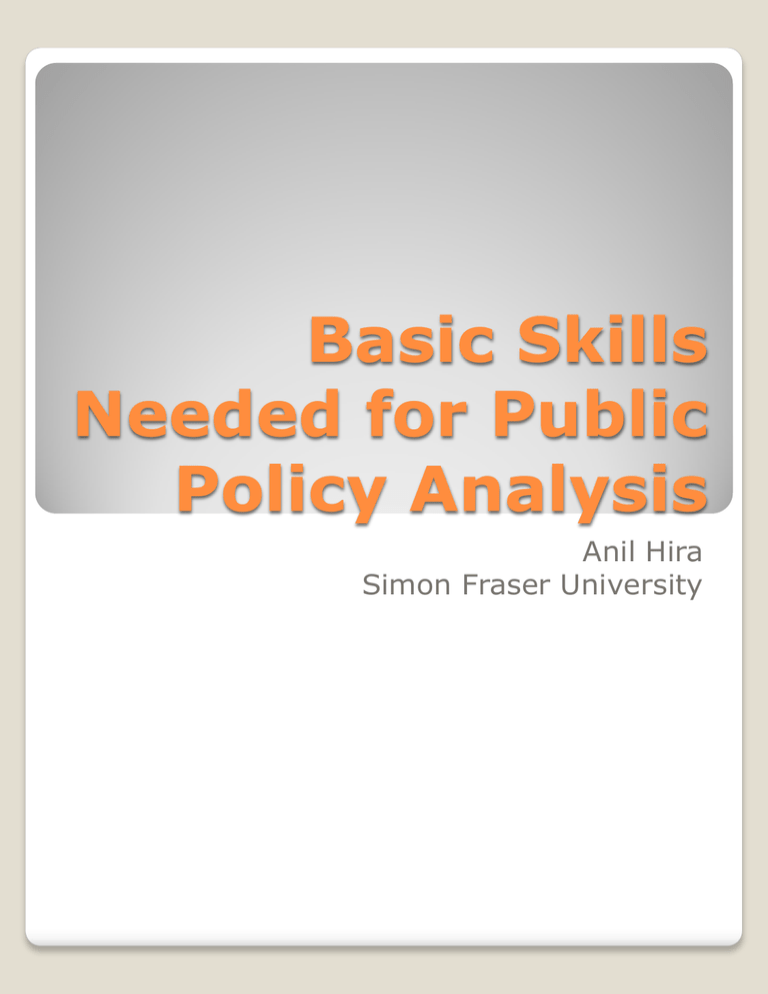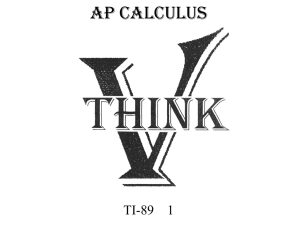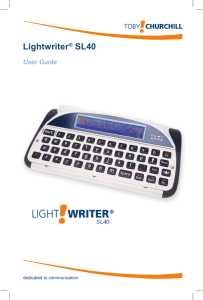Basic Skills Needed for Public Policy Analysis Anil Hira
advertisement

Basic Skills Needed for Public Policy Analysis Anil Hira Simon Fraser University 1. time management 2. critical reading & note takingmapping a route through a sea of info. 3. clear, logical, sequential, pragmatic thinking to solve problems 4. top notch research and synthesis 5. solid quantitative and qualitative data analysis 6. abstract thinking- using and creating frameworks for analysis 7. original, exciting, and to the point writing and verbal skills that can persuade a skeptical audience Examples follow: I provide guidance and feedback but you have to do the work. What skill sets are needed? Hard work, hard work, hard work Planning- never enough time, but need structured daily time for each task: reading, reflection, writing (multitasking does not work) Daily, steady work Communication to nip problems in the bud Time management Do not read word for word. Read key titles and intro and conclusion. Understand the logic of the argument. Focus in on the sections needed. Examine the methodology. Take notes. Compare to other authors. Why do they differ? Prepare questions/comments for meeting. See my shape of writing Critical Reading Identify the key question and the sub-q.s. Criticize, but then suggest pragmatically and feasibly. Understand the constraints of knowledge, methods, context. Examine generalizations, assumptions, metaphors, appropriateness of cases/data (methods) for answering the question posed. Suggestion and examine alternatives. Which are practical, from a technical, economic, and political pov? Why do you favour a particular alternative? Logical Thinking Use books as your first step. Articles are 2nd. Then public policy reports. Internet search comes last. Know what you are looking for; what q.s you want to answer. You will have to read context first. Do not over-generalize. Define the frontiers of knowledge. Borrow frameworks. Use original data. Research Skills Analysis covers a problem that recurs across space and time. A framework can be applied successfully to a variety of situations. A set of hypos from the framework are only valuable if they are falsifiable. Do not prove the obvious. Match questions to variables, actors, relationships, and data. Run the test and be prepared to interpret all of the possible outcomes. Analysis Use the least amount of words possible.- edit, edit, edit Have a clear idea. Create a blueprint. Get multiple feedback. Embrace criticism. Use peer review, learning commons, communicate with profs before sinking in too much time. Writing allows for complexitybut this requires depth of reflection and time for creating multiple layers of questions, logic, and testing. Writing well Introduction -general & specific importance of issue -tie in to class, audience -Key research question- categories & methods of evidence Preview key points of argument Keys 1: Modularity, Linkages, symmetryWrite an outline with nested logic! Literature Review -Addresses what we know about the q. now -includes schools of thought/logical approaches, and key authors -analyzes these in contrast to each other , offering a new synthetic view Keys 2: Trajectory no repetition; originality Data Analysis -reviews hard empirical evidence, incl. stats and case studies -discusses empirical literature and its conclusions about data -again, offers new synthetic view Original Analysis -offers a new theoretical and empirical analysis -explains superiority of this view -applied to case(s) or stats-cond’ns, assumptions Conclusion -answers research questions w/approp. conditionalities -summarizes implications of new analysis, for lit, data, & policy -gives policy & future research recommendations Keys 3: Concise, no repetition, economy of words; graphs, tables, formatting inviting to the reader Type in numbers, eg Country by year Hit graph button You now have a graph. Cut and paste with source into your Word document Using Excel



